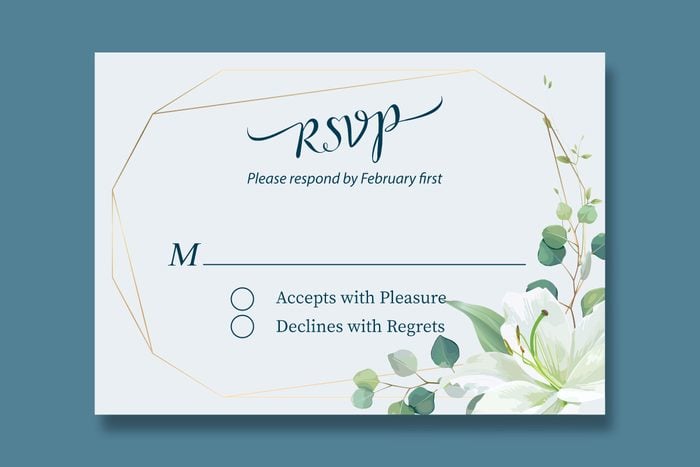If You See an “M” on an RSVP Card, This Is What It Means
Updated: Apr. 14, 2024
Consider it the letter that stumps party guests time and time again.
There’s a party coming up and you’re invited! You got the invite, which has all the information you need about where and when the party is. It might even have a “P.S.” with info about gifts to give or what to wear. Now it’s your turn—you should be courteous and RSVP to the invite by the indicated time. Many invitations, especially to larger, fancier events, will include a response card for you to RSVP and send back. A lot of these RSVP cards have a line on them preceded by a capital M. Is your name supposed to go there? If so, what does that M mean? And, for that matter, what does RSVP stand for in the first place?
What does the “M” mean on RSVP cards?
“M is simply the beginning of someone’s title,” explains etiquette expert Lisa Grotts. “The custom may be dated, but it’s used for formal invitations even in this day and age.” That means that after the capital M, you’re supposed to write the rest of your title, whether that’s “Mr.,” “Mrs.,” “Miss,” or another. Perhaps your title is “Ms.”—but do you know what “Ms.” stands for?
How do you fill out RSVP cards?
If there is an RSVP card, you should fill it out to be courteous so that the host has a clear record of who is and isn’t attending. After you’ve consoled the lonely M with the rest of your title, add your name as well—and the names of anyone else attending with you. For this, you should check to see who is invited on the envelope. According to Southern Living, some invites may have an inner envelope, inside the envelope for the post office. The inner envelope usually contains the more specific info about who exactly is invited (for instance, you’ll see “Plus One” or “And Guest” here rather than on the outer envelope). If there’s no inner envelope, check who’s addressed on the outer envelope. And Grotts suggests writing the names of the people who are invited as closely as possible to how their names are written on the envelope—if all of those people are attending, of course. “For example, if an invitation is addressed to Mr. and Mrs. John Grotts, you would fill in the blank as Mr. and Mrs. John Grotts,” Grotts explains. By the way, “Mrs.” is a weird abbreviation in and of itself—why is there an “R” in it?
Once all the names are squared away, don’t forget to indicate whether or not you’re coming! Fill out any other fields on the invitation as well (such as meal choices). Southern Living also recommends indicating the number of guests rather than just checking off the corresponding box, for maximum clarity. And keep it neat! “The one thing a bride needs is the full name of her guest(s) for a headcount and a place card. She should not have to decipher your response (or penmanship),” Grotts instructs.
Does your invite need an RSVP card?
If even etiquette experts find this practice slightly old-fashioned, do you need to abide by it if you’re sending an invitation? No. “Many modern brides are dropping the response card M,” Grotts confirms. “The shift has moved toward a prompt for guests to write in their names vs. their formal title and surname, such as ‘Lisa and John Grotts.'” Instead of the M, you might see the word NAME instead. “An honorific such as Ms. or Mr. is a form of address that conveys title and respect,” Grotts says. “However, the prefix M doesn’t imply including your guests’ full names.” If you’re filling out an RSVP card without the M, you’re of course welcome to still include your title. But the evolving etiquette rules don’t require it, nor do they require including the M in the first place—clearing up some long-standing invitation confusion! Next, find out these other helpful etiquette rules to know.
Sources:
- Lisa Grotts, etiquette expert and Golden Rules Gal




